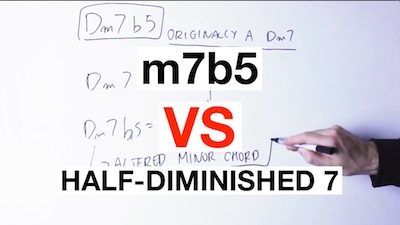The Important DIFFERENCE Between m7b5 And Half-Diminished 7 Chords


This is going to be controversial.
In fact I debated for a while if to make a video about this or not. I mean, what I'm about to say should be commonplace... but it's not.
I'm definitely taking the contrarian positions on this... so be it :)
So here's the story. There are two chords that behave in a different way and that they are even called in different ways... and yet everybody confuses them.
Worse than that... they even teach you that they are the same chord.
Even Wikipedia will tell you as much!
Hey, even I used to confuse them!!
Talk about the truth staring you in the face... they are called differently, they behave differently... and yet we were all thinking they were the same.
These two chords are the "half-diminished 7" and the "minor 7 flat 5".
And no, the explanation is not "they are the same chord, they are just called it differently in Jazz and in Classical harmony"
The explanation is: "they are two different chords, and for a good reason!"
(I can already hear the cries of protest to this last statement...)
So here we explain the real difference between "half-diminished 7" and "minor 7 flat 5", why everybody confuses them, and why it's important to NOT confuse them:
Now that you know the difference, you may be interested in how to use these chords in your songs and progressions.
In the next video we will see together how you can apply this sound to your music:
Of course, these are just a few of the many ways you can use these chords. the surprising thing, though is that all these ways to use chords (and many more) come from just a handful of simple principles.
If you want to move beyond 'tricks' and finally learn the principles that govern chord progressions, then check out the Complete Chord Mastery guitar course that organizes all the harmonic knowledge you need in a rational and practical way.
Did you find this video helpful? Do not miss the next Music Theory videos!
Subscribe to the MusicTheoryForGuitar YouTube channel by clicking the button below.